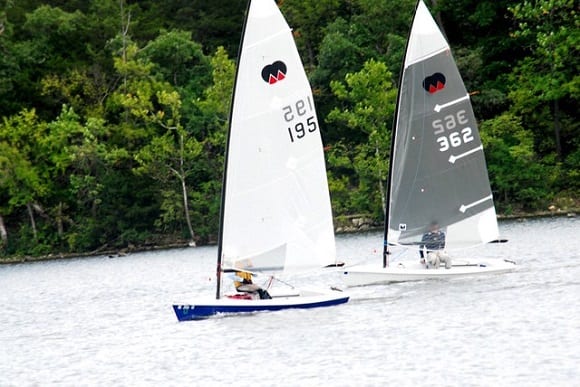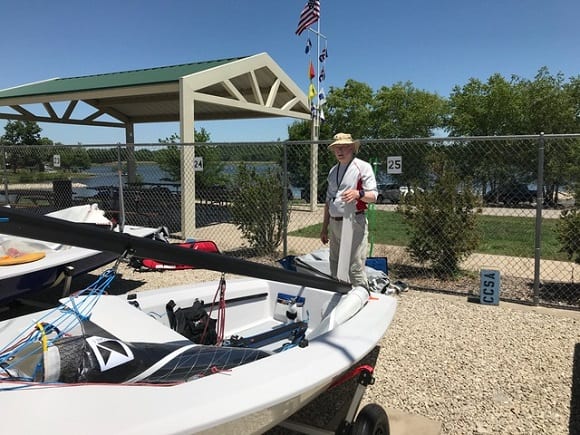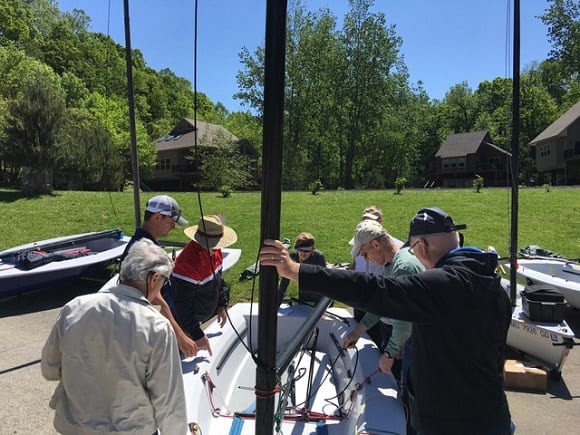How a small group of one design sailors started a successful local club in Jefferson City, Missouri.
US Sailing: Tell us how it all began?
Jim Crabtree: It began over a beer with a new resident who happened to be the new city manager of Jefferson City (population 45K+) in a “get to know each other” session. We started talking sailing and we wondered how many others in the area had a similar interest. I put an ad in the paper seeking others with sailing experience to join us the following Friday. Over 30 people showed up and then signed up if they had further interest. Those folks, about 15 or so, came to my house for coffee and I surprised them with a fully rigged Laser in the middle of the living room. It was here that the idea for setting up a local sailing club was born. It was this initial group of people that became the core of Capital City Sailing Association.
US Sailing: How many sailing clubs are in the Jefferson City area? Was this a way to fill a void?
Jim Crabtree: There were no sailing clubs nearby. The nearest ones were 150 miles west, 140 miles east and 50 miles south. This was a way to address a need locally. Binder Lake is small but workable. It has a flat shoreline situated SW/NE with prevailing winds from the SW. We draw club members from a 45-mile radius or so from Jefferson City, with some driving an hour to get here!
US Sailing: Did boat acquisition happen before the club was established or the did the club happen before the boats?
Jim Crabtree: Boat selection was critical to the mission. After a few more meetings, we decided to all start with the same boat, a one design. Some were interested in the Laser and others wanted to be able to sail with a spouse. Our members represented a broad range of experience and abilities. I agreed to start a search for a two person, simple dingy. I obtained five charter boat JY15s after a big event in St. Petersburg and by the time they arrived in Jefferson City all were sold. Using my network, I found another three used JY15s to be owned by the club, so the fleet was born. With a little TLC, these used club-owned boats provided the foundation for new club members since they could join us sailing and racing without having to own a boat. Working with the Parks and Recreation Director for Jefferson City, an agreement was reached to help build dry storage and a pavilion as a “base” for the club. My experience as a planning and landscape architecture specialist helped in the design and plan for the facility.
US Sailing: How have you engaged the community?
Jim Crabtree: As the commitment from the City was secure, we started to grow the fleet, especially by providing club-owned boats for new members to use. Two open houses a year in the spring and fall to help raise awareness and bring in members. Our “Learn to Sail” program runs in the month of July over three Saturdays using US Sailing Start Sailing Right. The fourth Saturday is about getting out in a boat solo or with a club member for a “fun sail”. Sometimes this is a racing event emphasizing fun in nature and gets everyone engaged. Wetting the whistle for that aspect of sailing.
US Sailing: How did/do you fleet build? How did/do you keep it affordable?
Jim Crabtree: Initially the club owned three boats and there were the privately owned five JY15s. I always was on the lookout for other boats to add to the fleet. From the JY we branched out into singlehanded with the megabyte, a user-friendly boat for the club members and one on which a parent could take a child out with them. I kept up the search for boats and connected club members to those, and then kept searching and connecting members. The other need that arose was a need for a family boat. The Flying Scot was a natural fit. With the learn to sail program, we had very diverse level of interest. We thought if we had a slightly larger boat that could accommodate three students plus an instructor, it would be ideal. I bought two used Flying Scots, fixed them up for club owned boats. I also personally bought two other Flying Scots and sold them to members. Over the past 12 years I have purchased and sold approximately 19 boats, with the intention of having them remain in our club.
US Sailing: How many fleets do you have now, and how do you keep them active?
Jim Crabtree: We have the FS (7 boats), the JY (7 boats), and the Megabyte (5 boats) fleets. Use of the JY is diminishing due to wear and tear over time, but we are replacing those with club 420s. We also have a Comet, a Snipe, a Capri, and a Sunfish. Camaraderie and working on sailing relationships keeps our members and fleets active. The Wednesday night fun sail with food and drinks brings the more casual and new sailors out. We always have post sail discussions that are informal and fun. We help the more serious to arrange travel and crew to events on Carlyle or Clinton Lake for fleet racing. Low key scoring with just whoever crosses the line is common and we do regattas using PY with the miscellaneous fleets.
US Sailing: What is the makeup of club membership? How many did you have initially and how many now?
Jim Crabtree: Our current membership stands at 30, which represents about 60 people. Very diverse in age, gender, and experience with ethnic diversity as well. Now we need to focus on youth sailing. Student memberships are free! We need to reach out to the youth more. We are an all-volunteer organization. People take on leadership roles for all aspects of the club. We continually nurture and encourage new leadership and fresh ideas, and that keeps the passion alive.
US Sailing: How do people learn how to race? Is there a mentorship program?
Jim Crabtree: Club members take new sailors out on a boat. We use racing as a learning tool and encourage newcomers to follow us around the racecourse. They get themselves around the racecourse and then mentoring discussions follow. Informal mentoring seems to work.
US Sailing: You seem to have been the “Boat Whisperer”, the fleet builder, the man behind the curtain. What keeps you motivated to do that?
Jim Crabtree: I have a passion for sailing! My life journey through sailing stemmed from people who took the time to help me along the way. It is something I like to give back to. I love winter boat projects to work on, to tinker with, but there is nothing more rewarding than to get a boat in working order and connect it to someone who is really engaged by making it affordable.
US Sailing: Has the work been worth it?
Jim Crabtree: Absolutely! You start with nothing and you watch the number of people whose passion grows and who stays engaged. Sailing is a great sport for fostering growth and community. One boat at a time.
US Sailing: What would you recommend to other sailors who are interested in getting fleets and/or sailing going in their area?
Jim Crabtree: One, generate a core group with enthusiasm and passions for sailing. Take a patience pill when things get rough. Club-owned boats are the key to get folks started. They can learn surrounded by folks who can guide them. One design boats with strong support from other one design sailors helps foster growth and participation. The idea is to give them a taste, get them to want to own their own boat, and then allow new folks to start in the older boats. It keeps the cycle going. Go into it knowing that you don’t do it to make money or even break even. You do it to pay it forward!
About the Author
Jim Crabtree is a lifelong sailor who brought his passion to the Midwest where he helped found the Capital City Sailing Association. He served as Commodore of Capital City Sailing for 10 years and was President of the Megabyte Class. Crabtree was part of the US Sailing working group that helped to design the new One Design Central webpage and now serves on the One Design Committee.
Please visit One Design Central for more one design sailing resources and information.



